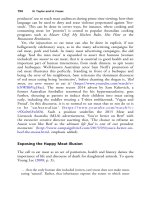The palgrave international handbook of a 478
Bạn đang xem bản rút gọn của tài liệu. Xem và tải ngay bản đầy đủ của tài liệu tại đây (28.12 KB, 1 trang )
480
R. Hediger
As cultures improved their understanding of working with and breeding
horses, the animals became larger (DiMarco 2008, p. 8). Horse cultures also
launched the history of ever-developing and evolving ensembles of tools,
weapons, and animals, a process which persists to this day. From the war cart
to the chariot, from the smaller to the larger horse, and from the bow and
arrow to gunpowder, horses would remain crucial to these innovations and to
the cultures organized around them. Because each advance was often duplicated by or answered by opposing forces (Keegan 1993, p. 175), horses have
long been caught in the middle of complex scenarios, assemblages of
humans, animals, tools, and cultures that no person exactly controlled.
As Keegan argues, the chariot would remain important for later groups,
including the significant Assyrians in the Middle East. Keegan claims that
‘the Assyrian army remained at heart a charioteering force’ (1993, p. 172),
but that, ironically, the Assyrians seemed to be responsible for the switch
to cavalry, a change that led to their downfall (1993, p. 177). The
Scythians were ‘a horse people’ (Keegan 1993, p. 177), and their success
against the Assyrians signals the importance of the cavalry horse to subsequent events. For instance, the Persians and their opponents the Greeks
relied deeply on riding horses, an approach in use up through the present
day, to some extent, in Afghanistan and elsewhere. Keegan summarizes
this reality deftly:
the first Scythians [ . . . ] were harbingers of what was to be a repetitive cycle of
raiding, despoliation, slave-taking, killing and, sometimes, conquest that was to
afflict the outer edge of civilization—in the Middle East, in India, in China and
in Europe—for 2000 years. These persistent attacks on the outer edge of
civilization of course had profoundly transforming effects on its inner nature,
to such an extent that we may regard the steppe nomads as one of the most
significant—and baleful—forces in military history. The innocent agents of the
harm they were to do were the descendants of the little, rough-coated ponies
which man had been breeding and eating on the Volga only a few dozen
generations before [ . . . ]. (1993, p. 178)
Of course, the horses were not the only ‘agents’. Their importance derives
partly from their intimate relationship with the human culture and technology
of the steppe, a point made by many sources. In Kistler’s words, the ‘steppe
peoples’ personal and public lives revolved around their horses’. He notes that
children learned to ride very young, that clothes and equipment were made
from horses, that horses were altogether central to steppe life, a point also made
clear repeatedly in Anthony’s book (Anthony 2007; Kistler 2011, p. 121).









